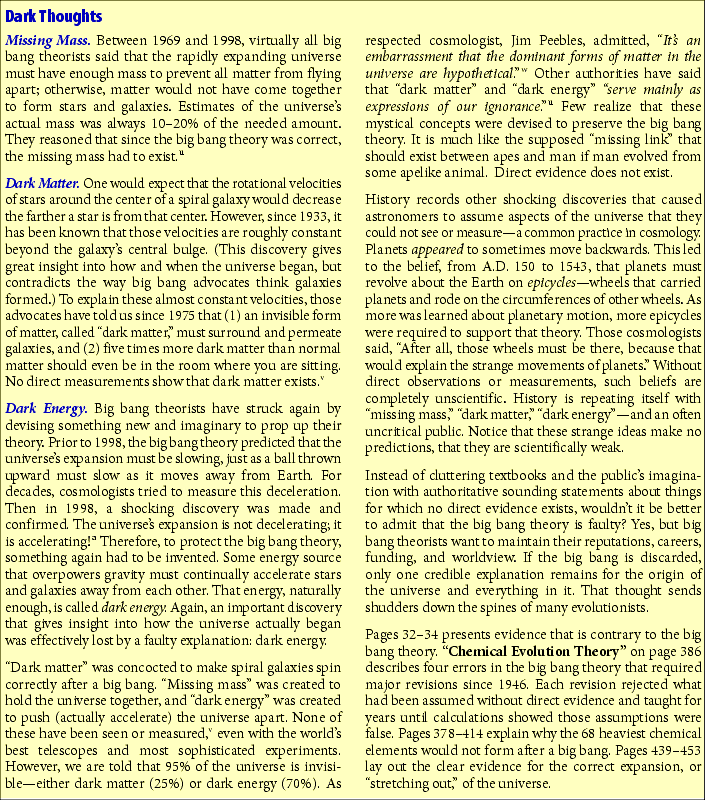56. Big Bang?
The big bang theory, now known to be seriously flawed,a was based on three observations: the redshift of light from distant stars, the cosmic microwave background (CMB) radiation, and the amount of helium in the universe. All three, if correctly understood, contradict the big bang theory.
Redshift. The redshift of starlight is a Doppler effect;b that is, stars and galaxies are moving away from Earth, stretching out (or reddening) the wavelengths of light they emit. Because the more distant stars and galaxies have a greater redshift, the space between these bodies is increasing—a fact so consistently observed that it is called “Hubble’s Law,” after Edwin Hubble who discovered it in 1929.
Space itself has expanded—so the total potential energy of stars, galaxies, and other matter has increased with no corresponding loss of energy elsewhere.c These galaxies, in their recession from us, should be decelerating, but to the surprise of everyone, measurements showed the opposite; galaxies are accelerating. Thus, the big bang violates the law of conservation of energy, probably the most important of all physical laws. [See “Dark Thoughts” on page 33.]
Many objects with high redshifts seem connected, or associated, with objects having low redshifts. They could not be traveling at such different velocities and stay connected for long. [See "Connected Galaxies" and "Galaxy Clusters" on page 43.] For example, many quasars have very high redshifts, and yet they statistically cluster with galaxies having low redshifts.d Some quasars seem to be connected to galaxies by threads of gas.e Many quasar redshifts are so great that the massive quasars would need to have formed too soon after the big bang—a contradiction of the theory.f
Finally, redshifted light from galaxies has some strange features inconsistent with the Doppler effect. Because redshifts are caused by the motion of objects moving away from Earth, one would expect redshifts to have continuous values. Instead, redshifts cluster at specific, evenly-spaced values.g It is as strange as seeing all cars on a highway traveling at an odd number of miles per hour, and nothing in between. Much remains to be learned about redshifts.
CMB. All matter radiates heat, regardless of its temperature. Astronomers can detect an extremely uniform radiation, called cosmic microwave background (CMB) radiation, coming from all directions. It appears to come from perfectly radiating matter whose temperature is 2.73 K—nearly absolute zero. Many incorrectly believe that the big bang theory predicted this radiation.h
Matter in the universe is highly concentrated into galaxies, galaxy clusters, and superclusters—as far as the most powerful telescopes can see.i Because the CMB is so uniform, many thought it came from evenly spread matter soon after a big bang. But such uniformly distributed matter would hardly gravitate in any direction. Even after tens of billions of years, 1–3 trillion visible galaxies and much larger structures would not evolve. Simply stated, the big bang did not produce the CMB.j [See pages 459–461.]
Helium. Contrary to what is commonly taught, the big bang theory does not explain the amount of helium in the universe; the theory was adjusted to fit the amount of helium.k Ironically, the lack of helium in certain types of stars (B type stars)l and the presence of beryllium and boron in “older” starsm contradict the big bang theory.

A big bang would produce only hydrogen, helium, and a trace of lithium, so the first generation of stars to somehow form after a big bang should consist only of those elements. Some of these stars should still exist, but despite extensive searches, none have been found.n
Two Lithium Problems. The total amount of lithium seen in and outside our galaxy is only a third of what the big bang theory predicts.o Also, “old stars contain one-quarter to one-half as much lithium-7 (made of three protons and four neutrons) as [the big bang] theory predicts and contain 1,000 times more lithium-6 (three protons and three neutrons) than expected [by the big bang theory].”p
Antimatter. For every charged particle in the universe, the big bang should have produced an identical particle but with the opposite electrical charge and spin.q (For example, the negatively charged electron’s antiparticle is the positively charged positron, and the positively charged proton’s antiparticle is the negatively charged antiproton.) Only trivial amounts of antimatter exist, even in other galaxies.r
Other Problems. If the big bang occurred, we should not see massive galaxies or quasars at such great distances, but they are seen. [See “Distant Galaxies” on page 445.] Nor should a big bang produce rotating bodiess such as galaxies and galaxy clusters. Also, a large volume of the universe should not be—but evidently is—moving sideways, almost perpendicular to the direction of apparent expansion.t
Also, if a big bang occurred, what caused the bang? Stars with enough mass become black holes, so not even light can escape their enormous gravity. How then could anything escape the trillions upon trillions of times greater gravity caused by concentrating all the universe’s mass in a “cosmic egg” that existed before a big bang? x
If the big bang theory is correct, one can calculate the age of the universe. This age turns out to be younger than objects in the universe whose ages were estimated based on other evolutionary theories. Because this is logically impossible, one or both sets of theories must be incorrect.y All these observations make it doubtful that a big bang occurred.z